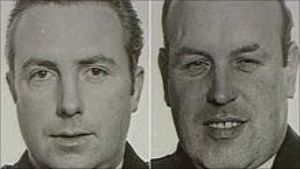`IRA used village massacre weapons` to murder RUC officers 13 years later, inquest told
Weapons used in the sectarian slaughter of ten Protestant workmen were also implicated in the deaths of two senior Royal Ulster Constabulary (RUC) officers more than a decade later, an inquest heard.
Weapons used in the sectarian slaughter of ten Protestant workmen were also implicated in the deaths of two senior Royal Ulster Constabulary (RUC) officers more than a decade later, an inquest heard. The ten men were ordered out of a bus and shot on January 5, 1976, in a County Armagh village in Northern Ireland, in what became known as the Kingsmill massacre. No-one has ever been convicted in connection with the killings. A group calling itself the South Armagh Reaction Force claimed responsibility, but a review by the Police Service of Northern Ireland (PSNI) Historical Enquiries Team stated the Provisional IRA carried out the attacks using a cover name. This week, at the Belfast Coroners` Court, the Kingsmill inquest resumed after being halted for almost a year. On Monday (May 15) security documents were read in court naming 13 suspects thought to be responsible for the massacre. For a second day a PSNI intelligence officer, identified only as `J2`, spoke from behind a screen about the weapons used in Kingsmill and their links to more than 40 other serious terrorist incidents over 15 years. These included the murder of two soldiers from the Parachute Regiment in March 1974 and the killing of five people at Tullyvallen Orange Hall in September 1975. Some of the weapons also resurfaced in 1989 in the murders of Chief Superintendent Harry Breen the most senior RUC officer killed in the Troubles and Superintendent Bob Buchanan. For the first time the court also heard intelligence suggesting the number of terrorist incidents the weapons were involved in, all within the same area, meant it was likely they were carried out by the same close group of killers. Sean Doran, counsel for the coroner, first presented to the court a joint intelligence document written by the RUC and the military on the Tullyvallen killings. Like Kingsmill, the South Armagh Reaction Force claimed responsibility, although the report insisted the IRA was to blame. Mr Doran said there was some friction in intelligence material about whether direction for the Tullyvallen killings came from the senior leadership of the IRA, with claims the group in south Armagh “was a law unto itself”. J2 said: “I`m not sure what was going on in the Provisional movement, there may have been issues with control. (But) it remains clear those involved were members of the PIRA at the time.” The focus in court then turned to the 11 weapons used in Kingsmill, with a timeline of their use presented on a paper scroll of around 6ft. The weapons included four Armalites, a 9mm sub machine-gun, a shotgun, two rifles, a semi-automatic rifle, a carbine and a 357 magnum revolver. Mr Doran said although the weapons were linked to multiple terrorist incidents, it did not mean the same individuals used them each time. He further stated the small timeframe and close locality suggested a close group of people were responsible, as moving the weapons frequently was impractical due to the heavy security presence at the time. J2 said: “Yes, that seems to be a fair assessment. “The history of the weapons would suggest they were used a number of times in that locality. “Historically the PIRA would have used quartermasters to monitor their weaponry. That would have ensured some form of accountability.” He also confirmed the 11 weapons detailed would have been typical for republican paramilitaries at the time. Stating the current PSNI position on Kingsmill, J2 said the PIRA were responsible, using the South Armagh Reaction Force as a cover. On Wednesday (May 17), a barrister representing some of the victims` families said the PSNI review had linked a “prime individual” to 46 murders that happened between 1974 to 1976. The killings included 22 civilians, one of whom was a seven-year-old boy. The other murders linked to the one suspect involved 21 soldiers, two police officers, and a paramilitary activist. The inquest is scheduled to continue until June 2.


